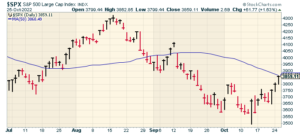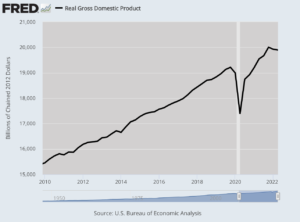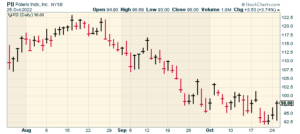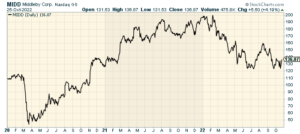CWS Market Review – October 25, 2022
(This is the free version of CWS Market Review. If you like what you see, then please sign up for the premium newsletter for $20 per month or $200 for the whole year. If you sign up today, you can see our two reports, “Your Handy Guide to Stock Orders” and “How Not to Get Screwed on Your Mortgage.”)
The Important Nugget Buried in the Fed Minutes
The stock market is finally showing some backbone. On Tuesday, the S&P 500 rallied 1.63% to close at its highest level in five weeks. The index finished the day less than 0.25% away from its 50-day moving average (the blue line in the chart below).
For traders, the 50-day moving average is an important psychological barrier. If we move above it, that could give more confidence to the bulls. The S&P 500 has traded below its 50-DMA nonstop for nearly six weeks.

I say this cautiously because we know how these bear market rallies like to fool us, but I have to confess that I’m more optimistic for the market’s latest move. Let me explain why.
For one, it’s been a far more measured climb. The S&P 500 hasn’t jerked forward by huge advances in a few days like we’ve seen in previous false starts. But more importantly, there may be concrete reasons why the Federal Reserve may alter its rate-hiking policy soon.
I’m referring to a small two-sentence blip buried in the minutes of the Fed’s last meeting. In fact, I overlooked it in my first reading.
First, some background. The stock market’s most recent closing low came on October 12. That’s when the S&P 500 finished the day at 3,577.03. The next day was a raucous one. The S&P 500 plunged as low as 3,491.58 which brought the stock market all the way back to its pre-Covid high from more than 30 months ago.
During the trading day, the Federal Reserve released the minutes from its September meeting. The overall tone of the minutes was quite hawkish. The Fed members clearly believe that the Fed needs to keep raising rates.
That’s what dominated the headlines. However, the minutes also contained this brief section:
Several participants noted that, particularly in the current highly uncertain global economic and financial environment, it would be important to calibrate the pace of further policy tightening with the aim of mitigating the risk of significant adverse effects on the economic outlook. Participants observed that, as the stance of monetary policy tightened further, it would become appropriate at some point to slow the pace of policy rate increases while assessing the effects of cumulative policy adjustments on economic activity and inflation.
I added the boldface. Why is this important? It means that some members inside the Fed recognize that there’s a limit to the Fed’s current policy. The yield curve is already inverted. Interest rates can only go so high. Perhaps we don’t know exactly what that level is, but the negative effects will soon become clear. To use the buzzword of this year, the Fed needs an offramp and some FOMC members are already discussing it.
I don’t think the Fed will alter course immediately, but it’s a real possibility within the next few months. We now have solid evidence that the Fed’s higher interest rates are causing harm to the economy.
I could be premature, but the stock market appears to have picked up the signal. After the minutes came out on October 13, the stock market staged a dramatic U-turn and closed higher by 2.6%. From low to close, the S&P 500 gained more than 5% that day.
The following day, October 14, was the day of the CPI report. Once again, the numbers were higher than expected, and the stock market dropped, but here’s what’s important: the low from the 12th held. The market didn’t make a new low. This tells me that the minutes were a turning point. Since then, the S&P 500 has rallied five times in seven days.
Let’s be clear that the Fed isn’t about to stop. The central bank will almost certainly raise short-term rates by 0.75% at its meeting next week. After that, the Fed meets again in mid-December. The futures market is evenly split on the odds of a 0.5% increase or another 0.75% increase.
After that, things may start to change. Except for one or two smaller rate increases, the Fed will probably hold tight for much of 2023. If the economic news is dire, then we may even see rate cuts before this time next year.
Let’s remember that the stock market peaked in January. The first Fed rate hike wasn’t until March. It’s natural for stocks to move before the news, even if the full details aren’t completely known. The initial move we’ve had over the last two weeks could be an omen for a friendlier Fed in 2023. This bear-market rally could finally be real.
Thursday’s Q3 GDP Report
While this week will be dominated by earnings news, on Thursday, the government will release its first estimate for Q3 GDP. This will be a noteworthy report because the first two quarters showed negative growth.
Two or more consecutive quarters of negative growth is often used as a shorthand for a recession. That’s not the technical definition used by most economists. Still, it’s an alarming thing to see two quarters in a row of falling real GDP. To be fair, the consumer side of the economy has seen some slow growth.

The consensus on Wall Street is that the U.S. economy will post growth of 2.3% for Q3 (that’s the annualized after-inflation number). I think there’s a good chance we’ll exceed that number, but that doesn’t mean the economy is in full health.
The weak spot is the housing market. Unfortunately, the housing market become the chief mechanism for Fed policy. I wish there were a better way to curb inflation without flattening the housing market. Mortgage demand is now at a 25-year low. Applications to refinance a home are down 86% from one year ago.
Update on Polaris
Before I get to this week’s stock, I wanted to pass along an update on Polaris (PII). I featured the stock for you in August.
Polaris is a cool company. They make snowmobiles and all sorts of off-road vehicles. I like Polaris because it’s a good example of a company with a wide “moat.” Not many firms can do what they do.
In April, Polaris bombed its Q1 report. The company earned $1.29 per share which was 49 cents below expectations. Sales were flat. This summer, Polaris rebounded with a good Q2 report. The company made $2.42 per share which beat the Street by 33 cents. Sales were up 8% to $2.063 billion.
This morning, Polaris reported another solid quarter. For Q3, the company made $3.25 per share. That’s up 65% over last year. Wall Street had been expecting $2.82 per share.

Polaris also increased its full-year guidance (of course, that’s only for one more quarter). The company now expects 2022 sales to rise by 15% to 16%. The previous guidance was 13% to 16%, and before that it was 12% to 15%.
Polaris also reiterated its full-year guidance of $10.10 to $10.30 per share. In the first three quarters of this year, Polaris made $6.98 per share so the guidance implies Q4 earnings of $3.12 to $3.32 per share.
That’s up 11% to 14% over last year. If those forecasts are accurate, that means Polaris is going for less than 10 times this year’s earnings. Not that long ago, Polaris would have gone for twice that valuation. One more thing: Polaris has increased its dividend every year for the last 27 years. The stock rallied 3.7% today, but it’s down significantly in the last few months.
Another stock I want to highlight is Middleby (MIDD). You may remember that we had Middleby on our Buy List in 2020 and 2021. It was our second-best performer last year with a gain of 52%. I decided against including it on this year’s Buy List, and I had pretty good timing. The shares are down more than 30% this year.
But Middleby is worth a look, especially at a discounted price. If you’re not familiar with Middleby, the company makes kitchen equipment for hotels and restaurants. Think big ovens and grills, and stuff with conveyer belts. The stock got demolished during the Covid panic in early 2020. Then it roared back and we did very well with Middleby.
So far this year, Middleby beat earnings for Q1 and Q2. For Q3, Wall Street expects $2.36 per share. For next year, Wall Street expects earnings of $10.29 per share. That means the stock is going for just over 13 times earnings. That’s not bad. The Q3 report will probably be out in early November.

That’s all for now. I’ll have more for you in the next issue of CWS Market Review.
– Eddy
P.S. If you want to learn more about the stocks on our Buy List, please sign up for our premium service. It’s $20 per month, or $200 per an entire year.
Posted by Eddy Elfenbein on October 25th, 2022 at 6:21 pm
The information in this blog post represents my own opinions and does not contain a recommendation for any particular security or investment. I or my affiliates may hold positions or other interests in securities mentioned in the Blog, please see my Disclaimer page for my full disclaimer.
- Tweets by @EddyElfenbein
-
-
Archives
- May 2024
- April 2024
- March 2024
- February 2024
- January 2024
- December 2023
- November 2023
- October 2023
- September 2023
- August 2023
- July 2023
- June 2023
- May 2023
- April 2023
- March 2023
- February 2023
- January 2023
- December 2022
- November 2022
- October 2022
- September 2022
- August 2022
- July 2022
- June 2022
- May 2022
- April 2022
- March 2022
- February 2022
- January 2022
- December 2021
- November 2021
- October 2021
- September 2021
- August 2021
- July 2021
- June 2021
- May 2021
- April 2021
- March 2021
- February 2021
- January 2021
- December 2020
- November 2020
- October 2020
- September 2020
- August 2020
- July 2020
- June 2020
- May 2020
- April 2020
- March 2020
- February 2020
- January 2020
- December 2019
- November 2019
- October 2019
- September 2019
- August 2019
- July 2019
- June 2019
- May 2019
- April 2019
- March 2019
- February 2019
- January 2019
- December 2018
- November 2018
- October 2018
- September 2018
- August 2018
- July 2018
- June 2018
- May 2018
- April 2018
- March 2018
- February 2018
- January 2018
- December 2017
- November 2017
- October 2017
- September 2017
- August 2017
- July 2017
- June 2017
- May 2017
- April 2017
- March 2017
- February 2017
- January 2017
- December 2016
- November 2016
- October 2016
- September 2016
- August 2016
- July 2016
- June 2016
- May 2016
- April 2016
- March 2016
- February 2016
- January 2016
- December 2015
- November 2015
- October 2015
- September 2015
- August 2015
- July 2015
- June 2015
- May 2015
- April 2015
- March 2015
- February 2015
- January 2015
- December 2014
- November 2014
- October 2014
- September 2014
- August 2014
- July 2014
- June 2014
- May 2014
- April 2014
- March 2014
- February 2014
- January 2014
- December 2013
- November 2013
- October 2013
- September 2013
- August 2013
- July 2013
- June 2013
- May 2013
- April 2013
- March 2013
- February 2013
- January 2013
- December 2012
- November 2012
- October 2012
- September 2012
- August 2012
- July 2012
- June 2012
- May 2012
- April 2012
- March 2012
- February 2012
- January 2012
- December 2011
- November 2011
- October 2011
- September 2011
- August 2011
- July 2011
- June 2011
- May 2011
- April 2011
- March 2011
- February 2011
- January 2011
- December 2010
- November 2010
- October 2010
- September 2010
- August 2010
- July 2010
- June 2010
- May 2010
- April 2010
- March 2010
- February 2010
- January 2010
- December 2009
- November 2009
- October 2009
- September 2009
- August 2009
- July 2009
- June 2009
- May 2009
- April 2009
- March 2009
- February 2009
- January 2009
- December 2008
- November 2008
- October 2008
- September 2008
- August 2008
- July 2008
- June 2008
- May 2008
- April 2008
- March 2008
- February 2008
- January 2008
- December 2007
- November 2007
- October 2007
- September 2007
- August 2007
- July 2007
- June 2007
- May 2007
- April 2007
- March 2007
- February 2007
- January 2007
- December 2006
- November 2006
- October 2006
- September 2006
- August 2006
- July 2006
- June 2006
- May 2006
- April 2006
- March 2006
- February 2006
- January 2006
- December 2005
- November 2005
- October 2005
- September 2005
- August 2005
- July 2005
 Eddy Elfenbein is a Washington, DC-based speaker, portfolio manager and editor of the blog Crossing Wall Street. His
Eddy Elfenbein is a Washington, DC-based speaker, portfolio manager and editor of the blog Crossing Wall Street. His